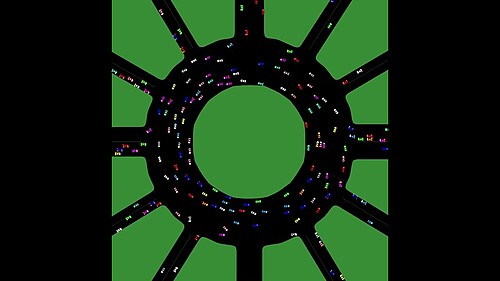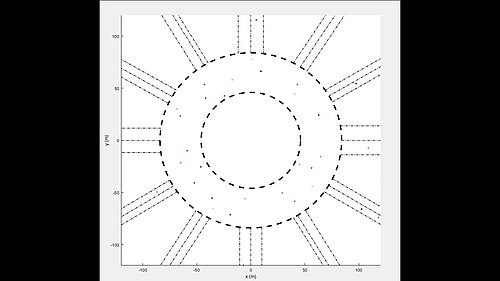Video Playlist 11. Controlling automated vehicles on large lane-free roundabouts
The videos included in this playlist are an outcome of the results firstly discussed in a conference paper entitled "Automated vehicle driving on large lane-free roundabouts", IEEE ITSC-2022, and then extended in a journal paper titled "Controlling automated vehicles on large lane-free roundabouts", IEEE Transactions on Intelligent Vehicles. Controlling automated vehicles on large lane-free roundabouts is challenging because of the geometrical complexity and frequent conflicts among vehicles. We have proposed a comprehensive methodology to control the vehicles within the roundabout and the connected road branches where a distributed (per vehicle) movement control strategy, using nonlinear feedback controllers, is employed to navigate each vehicle toward its destination, accounting for pre-specified position-dependent desired orientations and avoiding collisions with other vehicles; while boundary controllers guarantee that the roundabout boundaries are not violated, and the exit is not missed.
Microscopic simulation for the roundabout of Place Charles de Gaulle in Paris
This video illustrates the results of applying the suggested approach to an overly complicated case study, the famous roundabout of Place Charles de Gaulle in Paris, featuring a width of 38 m and comprising a dozen of bidirectional radial streets, hence a total of 144 Origin-Destination (OD) movements. The simulation is conducted in the TrafficFluid-Sim platform and involves a total of 1600 vehicles over a period of 27 minutes. All 144 OD routes are considered, and the individual OD demand flows are defined proportional to the product of the widths of the corresponding entrance and exit branches. The vehicles exiting at each specific destination are depicted with a corresponding color. For instance, blue vehicles exit from Champs-Élysées Avenue, the horizontal branch on the right. The video is about five times faster than real time. Further vehicle features and data are provided in the paper.
As shown in the video, vehicles move towards their destinations without exceeding the roundabout boundaries, though occasionally driving on them by the intervention of the boundary controller, and with no collision. When the roundabout is not crowded, they drive fast, close to their desired speed; occasionally, they may slow down to give way to other vehicles. In crowded situations, the vehicles’ desired speed decreases adaptively based on the surrounding density to mitigate conflicts. To avoid gridlock on the roundabout, some short-lived queues may appear in the entrance branches as vehicles enter the roundabout at a lower rate when the entrance density is high.

Preliminary simulation results
In this simulation which was conducted for the conference paper (ITSC 2022), 40 vehicles, entering from various branches, are appropriately guided toward their destinations while they do not exceed the boundaries, nor collide with each other. Also, perpendicular motions and sudden path changing are avoided in all involved situations i.e., entering, navigating, and exiting.

